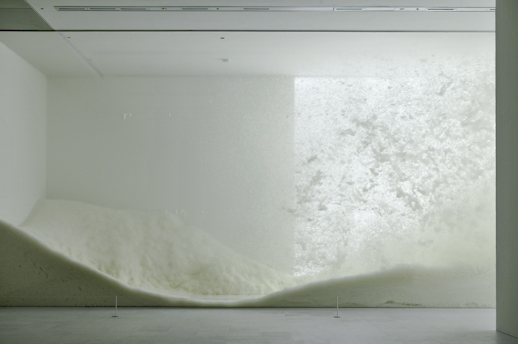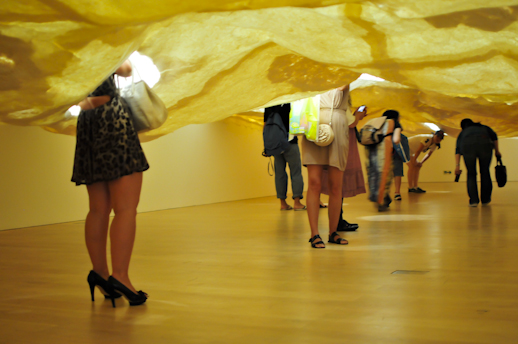All Five Senses
These are interesting times to be reconsidering the Japanese perception of Nature. With unusual heat waves abounding throughout Japan causing a stir in the geo/socio/media-spheres, it is clear that climate change is grabbing a firm hold and eradicating the traditional and nostalgic view of Japan’s firmly set four seasons. Three artists, Tokujin Yoshioka, Taro Shinoda and Takashi Kuribayashi, are presented by Mori Art Museum in the latest exhibition “Sensing Nature: Re-thinking Japanese perceptions of Nature.” Primarily through the form of installation, all draw upon a traditional Japanese sense of nature and reassess it for an audience at once familiar and unfamiliar with the Japanese perception.
‘SNOW’, an installation first shown in 1997 by Tokujin Yoshioka, provides us with a perfect introduction to the Japanese sense of nature. A white room, setting up an ambiance that is at once subtle and overwhelming in its sensory delight, we walk further and further with slight trepidation towards his work gradually succumbing to the simple perfection of it all. Encased in glass coupled with the simple use of a fan and feathers, he creates a beautiful cacophony that reminds us of traditional Japanese imagery of waves a la Hokusai. Through the use of industrial design materials, he reconsiders what most associate with the Japanese sense of nature: serenity, white, purity, and minimalism. The feathers float like snowflakes due to the fan, and it is this contingency and irregularity that leaves one breathless, as if a snowstorm could arise amidst the serenity at any given moment.

Looked at from afar, ‘The Light’ (2010) creates an entrancing illumination. Yoshioka hints at the first glimpse of sun after a long winter. ‘Water Block’ and the stunning ‘Waterfall’ (2005-06) are both made out of optical glass, not ordinarily used to describe the softness of water flowing. Belying the title, ‘Waterfall’ is a 4.5 meter table that is horizontally set, the world’s largest piece of the special optical glass used for space shuttles. The rippling effect is definitely of water, and looked at from any angle, the ‘legs’ of the table look like little fish, ready for the next seasonal swim into spring.
On the other hand, Taro Shinoda’s video installation ‘Reverberation’ suggests a grittier, realistic view of the Japanese sense of nature, incorporating the darker industrial facets of Tokyo cityscapes, while maintaining a connection with the stillness of the Japanese garden. The titling couples together the reverberations of the heartbeat, thus resonating with all aspects of nature – the lakeside stillness, the ripples on the water, subtle autumnal gradations, the passageways underneath the bridges – Shinoda enables us to travel into his world of nature, that is in a word, of human nature. Inspired by an ancient Chinese creation philosophy, ‘Model of Oblivion’ (2006-10) is housed in a claustrophobic white room and is what appears to be pure white cliffs with red blood dripping. Even if this treads a fine line into mere shock value, if one observes closer it is apparent that Shinoda’s preoccupation is with man and nature, man and the cosmos. The sounds of droplets attached to plastic water bottles that are hung from the ceiling in ‘GINGA’ (2010) (the “galaxy”), are at once soothing and unnerving as we look into a circular well and inhale the faintest scent of milk – a particularly brilliant approach and final self-referential note, reminding us of our existence in the Milky Way.

Takashi Kuribayashi ‘Wald aus Wald’ (Forest from Forest) uses Japanese paper to recreate a forest where we start underneath, crawling, from the perspective of animals that inhabit and burrow, foraging and seeking through the organic warmth, finally finding a space to breathe and popping up to find strategically placed holes. On the surface it is in fact a gorgeous white forest, eerie in its stillness. Though more European in its visual expression (he is a graduate of Kunstakademie Dusseldorf), he combines his appreciation for the aesthetics of straight lines with the softness, fluidity and the organic, to confront the complexity and fragility of mapping. This can be more explicitly seen in ‘Inseln’ (Islands) (2010), a homage to Beuys no doubt. Beneath a tiny piece of circular glass, Kuribayashi focuses us into reconsidering what lies directly around us and to gaze from below at the mass of brown and grey. With playful summer nostalgia, ‘YATAI Trip’ (2010) integrates the Asian cultural phenomenology of outdoor food stands perfectly to suggest a ramshackle asymmetry. And the use of music and black and white film projected onto Japanese pulp in ‘Korea Yatai Trip’ (2009), becomes a continuation of his preoccupation with soft borders, perhaps reiterating his argument that man and nature interconnect.
It is clear throughout that the three artists — Tokujin Yoshioka with his minimalist approach, Taro Shinoda with his mix of the mechanical and the human, and Kuribayashi’s soft borders — each share a binding narrative that suggests the traditional Japanese perception of the four set seasons, of nature touched and untouched by man. For us to reconnect with nature, it must be felt through all forms and with all five senses.
For more images from the exhibition, see TABlog’s photo report.
Mio Coxon
Mio Coxon



